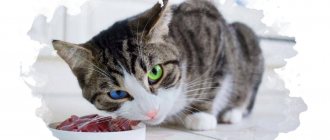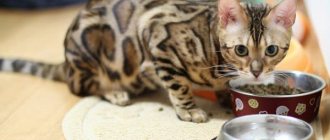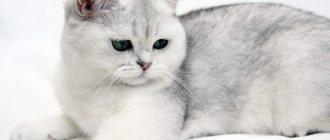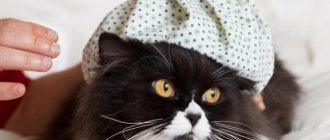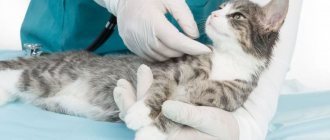After sterilization, the cat's body is rebuilt and entails changes in metabolism. Such changes reduce the concentration of sex hormones and animals begin to gain weight. They eat more, move less and gain weight quickly.
Also, sterilized cats are susceptible to urolithiasis. To cope with the unpleasant consequences of the operation, it is recommended to feed your pet with special food.
Change in behavior of a sterilized cat
To understand the importance of purchasing specialized food, you need to monitor what happens to the animal’s body after castration.
So, first of all, it loses its activity. The pet is now less playful and more calm. Physiological changes are not long in coming. The animal's blood hormonal composition changes, and interest in the opposite sex disappears. But your appetite is growing, so if you don’t change your diet, obesity may begin very soon.
Standard formulations can lead to the development of a number of dangerous diseases:
- urolithiasis. If a castrated cat receives too much trace elements such as magnesium, phosphorus or calcium, this can lead to the appearance of stones in the urinary system. In specialized feeds these substances are contained in the required quantities, which are absorbed by the body;
- obesity. The cat cannot control the amount of food it eats, so you must control its calorie content;
- diabetes Obesity in an advanced stage can lead to more serious consequences.
Features of special nutrition
Food for sterile animals helps:
- maintain weight;
- prevent diseases of the genitourinary system;
- maintain the health of the animal in accordance with its changing needs.
Be sure to read:
What to feed a castrated cat: diet recommended by veterinarians
Feed classes
After sterilization, do not leave your cat alone for the first time.
There are four classes of food:
- Economy Cheapest class. It is permissible to use bone dust and offal during production. Economy class includes Whiskas, Friskies, Kitekat.
- Premium . They contain a small amount of meat and a lot of offal. The most famous representatives are Hill's and Royal Canin.
- Super premium. Made from meat with small inclusions of offal. This class includes products from the Profine Adult Cat, 1st Choice, etc. brands.
- Holistic. Holistics are prepared in such a way that even a person can eat them if desired. These are products from professional developers and nutritionists, so their price is appropriate. This class includes Wellness, Eagle Pack Cat Canidae and Golden Eagle (N&D).
Attention! To feed a castrato, you need to choose a premium line or higher.
It is advisable to buy a product manufactured abroad: Royal Canin (Royal Canin), made in Germany or the UK, will be of better quality than domestic one.
Feeds developed taking into account the characteristics of castrated animals are more preferable than natural feeding.
Without a diet prepared by a veterinarian, the cat owner will not provide it with all the necessary substances.
Prohibited Products
Feeds developed taking into account the characteristics of castrated animals are more preferable than natural feeding. The following
are excluded from the diet of a neutered cat:
- lamb and pork;
- raw poultry;
- any dairy products;
- sweet foods, sweets, special chocolate;
- food with spices;
- smoked meats;
- fish in any form.
Particular attention should be paid to the last point. Fish has a large amount of phosphorus and magnesium.
They accelerate the formation of kidney stones, which is undesirable for castrates.
Difference between feeds
The difference between regular nutrition and specialized nutrition is:
- calorie content. Food for sterilized cats is lower in calories. This allows you to remain in excellent physical shape without changing the amount you eat. Standard feeds provide quick satiety due to their high calorie content;
- fat content Diet food can be considered low-fat. It is also often enriched with an element such as L-cartinine, which allows fat to turn into muscle. In standard food, the amount of fat is calculated to meet the needs of a healthy, active individual;
- content of microelements. The mineral complex in specialized feeds is specially selected, reducing the content of calcium, magnesium and phosphorus. Regular food contains a high content of vitamins and minerals.
Perfect Fit Sterile: general characteristics
In our top is the company that produces the famous Whiskas. But today we will talk about Perfect Fit food for sterilized cats. Reviews are often positive, especially highlighting the availability of products. Production is located both in Germany and in Russia. Wet and dry food are produced, which will be discussed. Before we look at what users and veterinarians say, let’s pay attention to the composition. Unlike Brit products, meat is completely replaced with chicken flour (20%). To ensure that the proteins are present in full, soy concentrate is used. It also contains flour of animal origin, which is not specified by the manufacturer. Users note that pets using this food are active, but not everyone is happy to eat the offered dish.
Diet food
- perfectly absorbed by the body;
- contains a large amount of dietary fiber for better digestion;
- maintains the health and mood of the animal.
The appearance of the cat will let you know whether the chosen diet is suitable for it. You can understand this by the appearance and behavior of the animal. A pet should eat with appetite, it should be tasty. The coat should be shiny and not come off in clumps. Your pet's stool should be regular without upset or constipation. The animal should not change its behavior.
Natural food after sterilization is not able to fully satisfy the body's needs, unless, of course, the owner is a professional veterinary nutritionist.
Choose the right food - keep your pets alive and healthy!
Basic requirements for composition
Dry food for neutered dogs should be low in calories, because after surgery the animal's metabolism decreases by ten percent. And your appetite increases by fifty.
Development companies produce special series for sterilized and low-active animals. The volume of lipids in these formulas is reduced by 12-13%. The amount of proteins, on the contrary, is increased so that the animals do not feel hungry.
To maintain health, fatty acids, vitamins, and antioxidants are additionally added to the composition.
Squirrels
Dry and wet food for sterilized dogs uses easily digestible proteins. Particular concern for animal health is characteristic of corporations producing holistic and super-premium formulas. They produce mixtures of natural ocean fish, chicken, turkey, and lamb.
Additionally, L-carnitine is added to the composition, which promotes fat burning.
Lipids
The fat content in diets is reduced. Along with carbohydrates, they are the main source of calories and the cause of excess weight. But neutered animals need healthy omega-3 and 6 fats. They are obtained from flax seeds, ocean fish, and vegetable oils.
Carbohydrates
The diet of dogs who have undergone surgery should contain a large amount of fiber, but a minimum of starch. Coarse fibers improve digestion and provide satiety. It is good if brown rice, oats, and barley are used as grains in the feed.
Wheat and corn are grains that are too difficult to digest and are not suitable for castrated animals.
Make sure that grains are not in first place on the list of ingredients.
Additional components
Pets that have undergone sterilization need to be additionally fed with vitamins, minerals, and prebiotics. All these components are already contained in mixtures of elite brands. The composition contains substances that accelerate metabolism and protect against urolithiasis.
Reviews
Anastasia, Moscow
“My sterilized British cat eats Royal Canin. Therefore, when, after forced castration, my Yorkshire Terrier began to rapidly gain weight, I decided to switch him to a special diet of the same brand. I took the variety for small breeds. York eats it with pleasure. I noticed that he had more strength and a desire to move. Finally, the dog began to take on its former shape.”
Igor, Vladivostok
“Before castration, we fed our Labrador Proplan. After the operation, the dog became lazy and began to gain weight. However, he still has an excellent appetite. At first we decided to switch him to the same brand of food, only with a reduced fat content. But it did not help. You may need to reduce portions or go for walks more often. Otherwise, there are no complaints. We haven’t noticed any special health problems yet, other than obesity.”
What not to feed: advice from veterinarians
It is important to exclude smoked meats, sausages and sausages from the diet of a sterilized cat.
The difference between natural and artificial food is obvious, but still some owners remain unconvinced and prefer to feed their sterilized pet regular food. Such nutrition undoubtedly has its advantages, but in this case it is important to familiarize yourself with the list of foods that should not be in the diet of a castrated animal. These include:
- salty, spicy, fried, fatty foods;
- bones, skin;
- mushrooms;
- borscht, fried soup;
- sausages, sausages;
- full-fat milk, sour cream, cream;
- sweets, chocolate;
- potatoes, beans;
- fatty meat and fish;
- food for dogs and other types of animals.
You shouldn’t skimp on high-quality store-bought food and buy an economy-class product for your animal. It contains many harmful additives, dyes, preservatives, while meat, vegetables and other useful components are completely absent. Sterilized cats happily eat cheap factory products due to the presence of flavor enhancers in them. However, this causes irreparable harm to health. Often, animals fed on Whiskas, Kitiket, etc. develop cardiovascular pathologies and the functioning of the kidneys and digestive organs is disrupted. To avoid such complications, it is recommended to contact an experienced veterinarian or breeder who can help you choose a quality product for your sterilized pet.
Types of ready-made cat food, categories, classes
Today, pet stores offer a huge range of products for our little brothers. But are all foods healthy and harmless to animals? Which is better, dry or wet food? Let's try to understand these issues.
Undoubtedly, it is quite difficult to say unequivocally which industrial feed can be called the best. Companies, brands, trademarks specializing in the production of food for cats create entire lines in which you can find food with a wide variety of tastes and properties.
If you believe the advertising, any food has a balanced composition and contains exclusively high-quality ingredients and components. In fact, this is only a successful marketing ploy, so it is best to consult with a veterinarian or experienced cat breeders when preparing a diet for your pet.
Classification of ready-made cat food:
Canned food. According to experts, canned food will appeal to even the most picky and demanding cats. They have high humidity, long shelf life, delicate texture, and a wide variety of flavors. After opening the jar, you need to consume the canned food within 12 hours. To prevent the contents from oxidizing, it is best to transfer it from a metal can to a ceramic bowl.
Wet food. Such products occupy an intermediate place between dry food and canned food. Delicious tidbits can be in sauce or jelly. As a rule, the bag is designed for one feeding. If your pet does not eat the offered portion at a time, put the bowl in the refrigerator and cover it with a lid. Otherwise, the food will lose its nutritional value and properties.
Dry prepared food. Available in the form of granules of various configurations and sizes. They have a long shelf life, a wide variety of flavors, compositions, do not spoil, do not weather in a bowl, so you can pour the food once and the cat will eat it in several sittings. Dry food is more concentrated and lasts a long time.
Each type of feed has its own composition, percentage of certain substances. On the packaging, the manufacturer indicates the content of all main ingredients, additives and components. The dosage must also be indicated, which is calculated according to the age, weight of the animal, calorie content of the product and its category.
All feed, regardless of the form in which it is produced, can be divided into several classes/categories:
- Economy class products.
- Super premium.
- Premium
- Elite.
- Holistic.
The line of well-known brands also includes specialized dietary, therapeutic and prophylactic, fortified foods. There is food that veterinarians prescribe for animals during the postoperative period for various pathologies and diseases, for example, food allergies, gastrointestinal disorders, urolithiasis, renal and liver failure.
Dry, wet, canned food for pregnant, lactating, castrated, sterilized cats and males deserve special attention. There are also products for small kittens and for first feeding.
Companies produce products for various breeds and age groups of cats. Therefore, if you plan to keep your pet on a ready-made type of food, you can easily choose a diet that corresponds to the physiological, breed, and individual characteristics of the body.




